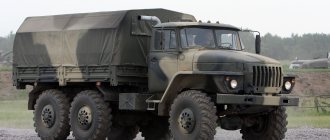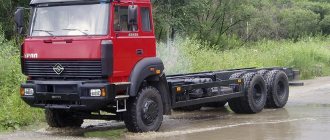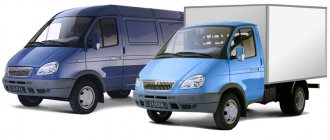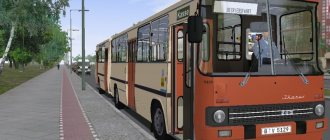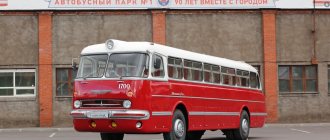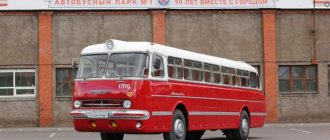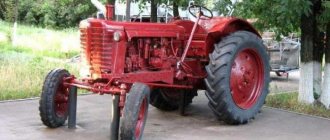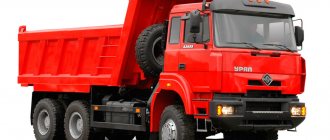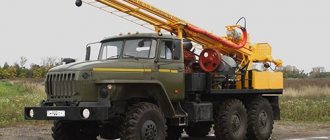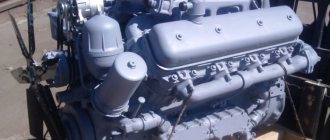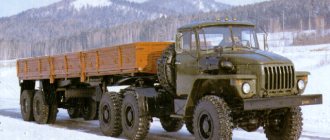08.10.2019
Trucks are an integral part of the country's economic activity. They also play an important role in supplying the army, providing the supply of equipment and ammunition, towing light weapons, as well as transporting personnel.
An important quality of such vehicles is not only their carrying capacity and reliability, but also their high cross-country ability. This aspect allows you to deliver cargo to any area, including difficult and uninhabited areas.
Ural-375 is one of these trucks. Developed in the second half of the 20th century, it remained in demand for a long time in all sectors of supply and logistics. There are still working samples of such machines that continue to regularly transport cargo.
What models were produced
The first copies of the powerful all-terrain vehicle appeared on the roads in 1961. The cabin was made with a removable fabric roof. They installed a flat windshield, which was raised when necessary. The model was produced for only three years. This version of the Ural 375 had not the worst characteristics, but not the best either.
Starting in 1964, a truck with the letter D was produced. It was equipped with a metal platform and a driver’s cab. For the convenience of passengers and loaders, a folding tailgate was installed. Benches and a driver signal button were placed in the back.
The first Ural 375 trucks had not very good fuel consumption characteristics. 70 liters of A-92 fuel were required for every 100 km. After modernization, consumption dropped to 50 liters per 100 km. On difficult terrain, in harsh winter engine operating conditions, gasoline consumption increased by another 20-30 liters.
Modification A was produced with longer spars. An army kung was installed on the model. The tank was moved down, the gas exhaust pipe system was installed in another place. A spare tire was hung on the rear overhang of the frame. The Ural-375T was created as a prototype for the next model with the letter N, and therefore was not mass-produced.
The model with the letter E was developed for the army; weapons and military equipment for various purposes were installed in the body. These were cars with:
- tank;
— generators;
- crane;
- rockets.
Radar stations were also installed in the body.
Many people know the military Ural-375SK1 and the civilian model SN. They were widely used throughout the country. In the army, the vehicle was also needed to transport missile systems. For operation in the coldest conditions, a model with the letter K was developed. It was equipped with low-temperature resistant rubber products, an additional radiator grille, and an insulated cabin.
The civilian model Ural-375N was also produced with a wooden platform, but with all folding sides. The truck did not have shielded electrical equipment or an air intake. The joints of the transmission elements were not sealed, and the tire pressure was not regulated.
Load capacity
Important! A special feature of the all-terrain tractor model “375D” was that its permitted load capacity varied depending on the condition of the road and soil on which it moved.
The 1961 model “375” had a carrying capacity of 4 tons, by 1964 the figure increased to 5 tons.
The basic modernized model “375D” had a carrying capacity of 5 tons on paved roads and 4.5 tons on the ground.
The 375A, having received an extended base, also acquired the ability to transport a larger load of 5.8 tons.
The 375NM machines for the national economy were also able to transport more than five tons. All Urals of these modifications were able to tow trailers with a payload of 10 tons.
The greatest load could be carried by the “375S” tractor-timber trucks, which towed semi-trailers with a 12-ton load, as well as the “375SN” and “375SNM” that appeared later.
These vehicles could transport semi-trailers with a load of 18.5 tons on paved roads.
Frame
The Ural-375 has a strong, high-quality riveted frame. It consisted of various stamped elements. Tow hooks were placed on the front side members.
| Ural-375, main characteristics | |
| Length | 7 360 mm |
| Width | 2,674 mm |
| Height | 2,980 mm |
| Load capacity | 5,000 kg |
| Maximum speed | 75 km/h |
| Curb weight | 8,300 kg |
| Full mass | 13,300 kg |
| Maximum towed trailer weight | 10,000 kg |
| Power unit | |
| Engine | ZIL-375 |
| Fuel consumption | 50 l, AI-92 |
| Power | 180 hp |
| Volume | 7 l |
| Platform | |
| Length | 3,900 mm |
| Width | 2 430 mm |
| Other characteristics | |
| Wheel formula | 6x6 |
| Transmission | YaMZ-24U, mechanical. |
| Fuel tank | 300+60 l |
| Tires | OI-25 |
Permissible filling volumes
For all main modifications, the filling volumes of working fluids are basically the same.
The difference is in the number of fuel tanks and, accordingly, the volume of fuel to be filled. Thus, models “375”, “375D” and “375K” have a fuel tank with a capacity of three hundred liters and an additional fuel tank of 60 liters.
The 375C truck tractor and its configurations have an additional fuel tank with a capacity of 110 liters. “375A” with a van body are not equipped with an additional tank and only have a standard one of 300 liters.
For normal operation of the engine and components, other liquids are filled, for example:
- oil to the engine lubrication system - maximum 9 liters;
- antifreeze for cooling the internal combustion engine - maximum 30 liters;
- gearbox oil - 4.5 liters;
- oil for transfer case - 3.5 liters;
- in the gearboxes of each axle - 4 liters;
- to the RU hydraulic system - 4.5 liters;
- to ensure the operation of the brake system - 2 liters.
Conclusion
Production of models of the Ural 375 family was stopped in 1992. Today you can still buy a truck in good condition. Many military vehicles have been mothballed for a long time. The model has a long service life and good reliability. The wheel arrangement of the truck has always been 6x6, and remained so for any modification.
Advantages of the truck:
— excellent driving performance, power and high maneuverability;
— unpretentiousness and reliability;
— ease of repair, interchangeability of spare parts with other modifications.
The only disadvantage of the Ural-375 is its high gasoline consumption. In the latest models, designers have managed to reduce operating costs. The cost of an all-terrain vehicle depends on its condition, year of manufacture, and ranges from 300-800 thousand rubles.
Ural-375 and its successor - Ural-4320. Other similar cars
In 1977, after the launch of the Kama association for the production of heavy-duty vehicles, Ural trucks began to be equipped not with gasoline, but with diesel engines of the KamAZ-740 series, with a capacity of 210 horsepower, which were much more economical.
The production of a new series of trucks, designated Ural-4320, with diesel engines, was gradually increased, while the production of the gasoline Ural-375, on the contrary, was curtailed.
By 1982, the Soviet Army completely switched from recruiting Urals-375 to Urals-4320, but the Urals-375 continued to serve until decommissioned, according to its service life (12 years). And production of the gasoline version of the SUV truck still continued at UralAZ, in limited quantities, until 1992.
By the way, there is an opinion that the Ural-375 had higher cross-country ability compared to its successor, the Ural-4320.
The ZIL-131 can be called a “classmate” vehicle similar to the Ural-375.
Manual
Service documentation, instructions, and operating instructions recommend:
- Change the speed of the transfer gearbox only when the vehicle is stationary.
- Continuous operation of equipment with a locked center differential is prohibited.
- Do not reduce tire pressure below 0.5 kgf/cm². During long periods of inactivity, close the wheel taps.
- Do not start movements when the pressure in the pneumatic system is below 4 kgf/cm².
- Check and adjust the gaps between the drums and pad linings.
Fuel consumption
According to information from the operating instructions, the Ural-375 truck, regardless of configuration, will consume 48 liters of fuel when operating in mixed mode.
Ural-375 - rear view
But in practice, it turned out that actual fuel consumption depends on many factors: terrain, quality of the road surface (for off-road driving you need 50% more fuel), temperature (driving in hot weather requires more gasoline than in cold weather), wear level car and its parts.
In addition to the above factors, the model of the truck also affects the range. So, according to the instructions, the 375C truck has a power reserve of 650 km, and the 375D – 750 km.
Such high gasoline consumption is the only significant drawback of the Ural-375. In an effort to solve it, specialists at the Ural plant began producing new cars that ran on diesel and required less fuel. They became increasingly popular, and by 1992 they had displaced gasoline-powered trucks from production.
Related video: Ural-375
Specifications
Engine
On the Ural 375D series model, 2 types of power plants were installed:
- gasoline engine ZIL-375. The 4-stroke unit has 8 cylinders rotating one crankshaft. This design is more reliable compared to the 6-cylinder. The motor is highly balanced and operates confidently at high loads and low speeds. The cylinder block is made of cast iron, the cylinder head is made of aluminum alloy. Characteristics: working volume – 7 l, rated power – 180 hp. For ZIL-375 it is recommended to use AI-92 gasoline;
- diesel unit KAMAZ-740. The engine has proven itself well in difficult conditions. The motor complies with the Euro-1 environmental class. Characteristics: displacement – 10.85 l, rated power – 210 hp, number of cylinders – 8 (V-shaped arrangement), maximum torque – 667 Nm.
Fuel consumption
According to the operating manual for the Ural of any configuration, fuel consumption in mixed mode is 48 liters.
However, during actual operation it was found that depending on the conditions in which a particular machine operates, fuel consumption also changes. In this regard, gasoline consumption standards have been established, which vary depending on the circumstances.
The amount of gasoline consumed by a car per 100 kilometers is influenced by many factors. This includes the height of the relief, the climatic conditions (less in hot climates, and much more in the Far North), and the degree of wear and tear on the machine and components.
The road surface or its complete absence also has a significant impact.
So, when driving off-road, gasoline consumption can increase by 50 percent. Therefore, in the technical specifications for the 375C truck tractor, the range is 650 km, despite the presence of an additional tank of 110 liters.
At the same time, the power reserve for the 375D is 750 kilometers. It is assumed that the truck tractor works as a timber carrier and moves along forest terrain or transports heavy semi-trailers.
Currently, they can be purchased at prices ranging from 300 to 800 thousand rubles. Despite the high fuel consumption during operation, interest in this equipment remains due to its unique maneuverability and fairly simple maintenance.
The production of Ural-375 and all its modifications ended in 1992. Nevertheless, these machines can still be purchased on the market. This is explained by the fact that a large amount of such equipment was mothballed for military needs.
Transmission
A double-disc clutch is used to transmit torque from the engine to the transmission. The YaAZ-204 gearbox is equipped with five forward gears, with the fifth speed being an accelerating speed and the fourth being a forward gear.
To expand the traction range and distribute the drive to three axles, a transfer case is used. Both speeds in the gearbox are reducing.
The gearbox of the Ural-375 vehicle includes a differential that proportionally divides the torque between the gearboxes of the front axle and the rear bogie. The differential is equipped with a forced locking mechanism.
A special feature of the transmission of the Ural-375 all-terrain vehicle is the permanently connected front axle drive. The design of the cardan shafts uses joints from ZIL and MAZ trucks. Early releases of the all-terrain vehicle were equipped with a transfer gearbox, which made it possible to disable the front axle drive.
Suspension
The front suspension of the Ural-375 includes two springs, complemented by telescopic shock absorbers.
The suspension elements are borrowed from the MAZ-500 flatbed truck.
The rear bogie has a balancing design and is equipped with two springs. The ends of the springs are inserted into support brackets placed on the stockings of the middle and rear axles. The middle axle is equipped with suspension travel limiters. The limiting elements are made of steel cable. The suspension includes reaction rods designed to transmit pushing and braking forces that arise when the Ural-375 all-terrain vehicle moves.
Chassis
The chassis of the Ural-375 all-terrain vehicle is based on a riveted frame. Frame elements are made by stamping. There are rigidly mounted tow hooks on the side members at the front.
Towing devices of various designs may be located on the rear part (depending on the modification). Truck tractors are equipped with a towing hook rigidly mounted on the frame, as well as a saddle borrowed from the MAZ-200V tractor. The remaining all-terrain vehicles are equipped with a hook with a lock and a spring shock absorber operating in both directions.
Bridges
The front axle on the Ural-375 all-terrain vehicle is equipped with rotating axles. The transmission of torque to the rotary wheels is carried out using constant velocity joints. On the civilian version of the Ural-377, a forged beam with an I-section is mounted at the front.
The rear axles have an interchangeable design.
The middle axle gearbox is a through-type gearbox, used to drive the rear axle. The axle gearboxes use a double main gear. The transmission includes a bevel pair and an additional cylindrical gear. The civilian and northern versions of the all-terrain vehicle were equipped with a gearbox with a gear ratio reduced to 8.05 (standard 8.9).
Steering
The steering of the Ural-375 all-terrain vehicle consists of a worm gearbox and a hydraulic booster. The gearbox includes a worm shaft with a double-start screw thread and a sector.
To operate the amplifier, a vane pump is used. The pump is mounted on the engine and is belt driven from a pulley on the crankshaft.
Brake system
The Ural-375 all-terrain vehicle is equipped with working brake mechanisms of a drum design. A special feature of the system is a combined drive, consisting of a pneumatic and hydraulic part.
The pneumatics operate from a 2-cylinder compressor installed on the power unit.
The pneumatic part of the drive has one circuit. The pads are directly driven from the hydraulic part, divided into two circuits. The first circuit is responsible for the operation of the front and middle axles. The rear axle brake drive is made from a secondary circuit. To hold the all-terrain vehicle in the parking lot, a separate drum brake is used, mounted on the secondary shaft of the transfer gearbox.
Devices
In front of the driver there is a dashboard with a standard set of instruments for Soviet trucks. A speedometer is installed in the center of the dashboard, on the right are indicators of the amount of fuel in the main tank and an on-board network status indicator, on the left is a coolant temperature indicator and an oil pressure indicator in the lubrication system. The all-terrain vehicle's shield is equipped with two backlight lamps covered with visors.
On the lower part there is a high beam headlight indicator and a turn signal indicator (with a green filter). To the left of the dashboard there are air pressure gauges in the tires and in the brake drive.
Under the instrument panel there is a number of indicators and switches (listed from the driver's door):
- red warning light for low oil pressure;
- light switch;
- red lamp for minimum tire pressure;
- a red lamp indicating an emergency condition of the brake system;
- cabin light switch;
- egnition lock;
- switches for the ventilation system and turning lights.
Fuel containers
The fuel supply on the Ural-375 all-terrain vehicle is located in the main tank with a capacity of 300 liters, as well as an additional tank designed for 60 liters. On civilian versions there is no additional tank. The main tank is mounted on brackets riveted to the left frame side member.
The northern version of the 375K all-terrain vehicle uses an additional 120-liter tank, and the truck tractor uses a 110-liter tank. On 375SK1 cars produced after 1977, there is no additional tank. The 375CH civilian truck tractor was equipped from the factory with a canister canister designed for 20 liters of gasoline.
Load capacity
The new Ural-375D model had an increased load capacity, which varied depending on the type of road surface on which the truck was moving. If the Ural-375 could transport only 4 tons, the 375D model increased this figure to 5 tons on paved roads and up to 4.5 tons on dirt roads. The vehicle, which had an extended wheelbase (Ural-375A), was capable of carrying cargo weighing up to 5.8 tons.
All modifications of the Ural-375D, which were intended for use in the national economy, had the ability to transport cargo weighing more than 5 tons. In addition, the weight of the towed trailer could reach 10 tons.
Timber tractors, which were produced under the designation “357C”, could tow semi-trailers with a total cargo weight of up to 12 tons. The “375SN” and “375SNM” models, which appeared a little later, transported semi-trailers with a total load of up to 18.5 tons along asphalt roads.
Device
The basis of the Ural 375 chassis was a stamped riveted frame made of sheet steel. It was originally equipped with a wooden platform for transporting goods and people and a metal cabin. The front towbar consists of 2 rigid towing hooks, the rear towbar is a 2-way towing device.
The front suspension included 2 longitudinal semi-elliptical springs, the front ends of which were attached to the frame by means of pins and lugs, and the rear ends were sliding. The suspension used double-acting hydraulic telescopic shock absorbers. The rear suspension was balanced and was based on 2 semi-elliptic springs on sliding supports. Restriction cables were provided for the middle bridge. The pushing forces were transmitted by reaction rods. The truck was driven by a front steered axle. The axle shafts included angular velocity disc joints.
The car used open-type foot brakes. Pads were installed on all wheels. The braking system included a joint pneumohydraulic drive for the middle and front axles and a separate pneumohydraulic drive for the rear axle. A drum-type hand brake with internal shoes was installed on the output shaft of the additional box. The drive was interlocked with the brake valve of conventional brakes to brake the trailer while parked.
The Ural 375 was equipped with a mechanical transmission model YaMZ-204U with 5 forward and 1 reverse gears. The gearbox had synchronizers at 2, 3, 4 and 5 speeds. Clutch – 2-disc dry with peripheral springs. The cardan transmission is open with 4 shafts.
The steering mechanism was located in the cabin on the left. On the latest modifications of the model, power steering appeared.
The wiring system in the Urals is 375 - 12 V (negative terminals are connected to the machine body). The DC generator is shielded, waterproof and driven by a V-belt from the crankshaft pulley.
For the Ural 375, special wheels with conical flanges, a spacer ring and split rims were used. The basic version came with OI-25 tires with variable pressure. Tire pressure control was centralized with an internal air supply. The adjustment was controlled directly from the cab.
The first models were equipped with a 3-seater metal cabin with folding window frames and a soft top. However, it was soon replaced by a 3-seater all-metal cabin with rotating windows, a blind wind window and sliding windows. Heating in the cabin is water-based from the cooling system (used to heat the glass and the cabin). The windshield was divided by a metal frame, providing additional rigidity. The side windows rolled down. Everything inside the cabin was as ascetic as possible. Hard seats and a minimal number of sensors (speedometer, mechanical clock, pressure gauge and several indicators) made the working conditions spartan.
Starting with the Ural 375D version, the car was equipped with a metal platform with a tailgate. It was equipped with a removable awning and folding benches. The front and side sides were extended and lattice.
Model dimensions:
- length – 7350 mm;
- width – 2690 mm;
- height – 2680 mm;
- height with awning – 2980 mm;
- wheelbase – 3525 + 1400 mm;
- ground clearance - 400 mm;
- rear track – 2000 mm;
- front track – 2000 mm;
- minimum turning radius – 10500 mm.
The vehicle weight is 8400 kg, load capacity is 4500 kg. The model can accelerate to 75 km/h. Braking distance at a speed of 40 km/h is 15 m. The maximum climbable grade is 40 degrees.
On the first versions of the Ural 375, fuel consumption was 65-70 l/100 km, on later versions - 48-50 l/100 km. Fuel consumption changed taking into account the conditions and characteristics of operation. So, when driving off-road, consumption increased by 40-50%. The car's power reserve was 650-700 km. The fuel tank of the model contained 360 l (300 l - main tank, 60 l - additional tank).
The truck has a 6 by 6 wheel arrangement, providing good cross-country ability.
Modifications
In 1964, the developers of the automobile plant made serious changes to the design of the Ural, and the 375D model was launched into mass production.
The main features of this machine were:
- all- metal cabin with two doors, without a sleeping bag, which can accommodate three people;
- to install a van-type body, the length of the frame was increased by more than 300 mm;
- the front axle became non-disconnectable , the transfer case changed;
- ZIL-375 engine on the car .
"375D" was the base model of the new "Ural". In subsequent years, new modifications of this vehicle in a wide variety of configurations began to be produced on its chassis.
For military needs, the BM-21 Grad launcher, AC tank trucks, ATMZ fuel tankers, 8T and 9T truck cranes, as well as the P 18 radar were produced on the 375D base.
In addition, staff KUNGs and vans with mobile repair shops were installed.
“375A” is a configuration with a KUNG K-375 body and a longer frame , the geometric dimensions of this variety are 8,000x2,500x2,680 mm. The 375E chassis was developed for various tanks, cranes and other special equipment.
For the purpose of transporting semi-trailers and using them as timber carriers, the 375S truck tractor and its modernized version 375SK1 were produced.
The 375K tractor was produced especially for the needs of the Far North and other places with difficult climatic conditions.
A cabin with double glass and improved thermal insulation, a reinforced heater for pre-launch preparation and special frost-resistant insulation of the electrical wiring made it possible to operate this machine at temperatures of minus sixty degrees Celsius.
With this configuration, special frost-resistant tires were also installed.
For use in the national economy, the “375N” model was produced.
The electrical wiring on this machine was not shielded, there was no automatic tire inflation, and the design of the units was not airtight. Another engine was installed on the car - ZIL-375YA4.
To tow heavy trailers up to 18.5 tons on paved roads, the Ural plant began producing the 375SN truck tractor with a shortened rear overhang. In the modernized version it was “375СНМ”.
A version of the machine for working in hot climates, “375Yu,” was provided. It was assumed that it would be able to operate uninterruptedly at temperatures from minus twenty to plus fifty degrees.
All major units - both power and electrical - had special additional insulation, and many metal parts were replaced with elements from non-metallic components.
Machines for export needs were marked “375ДУ” and “375ДМУ”.
According to its technical characteristics, the Bobcat S175 is a mini loader capable of working in difficult conditions in farming, public utilities and construction.
Studying this review will allow you to compare and note the advantages of various modifications of the Hyundai Porter.
"375D"
The technical characteristics of the Ural-375D are as follows:
- car dimensions in terms of dimensions - 7,350x2,690x2,680 mm, vehicle height along the awning - 2,980 mm;
- in the base car the body is in the form of a metal platform with lowering sides , it has folding seats for people.
The sides can be added with lattice structures. To protect passengers from wind and rain, an awning is used, installed on special arches, platform size 3,900x2,430x872 mm; - the track of the front and rear wheels is the same - 2,000 mm, ground clearance - 400 mm;
- the machine could make a turn with a radius of 10.5 m ;
- the cabin is completely made of metal, the front windshield does not roll down , it is divided in the middle by a metal insert for greater rigidity, the side windows in the doors are lowered, there are rotating windows;
- maximum travel speed - 75 km/h;
- the angle of the obstacle to be overcome is 40 degrees;
- the distance covered when braking from a speed of 40 km/h is 15 meters;
- the maximum possible distance covered without refueling while maintaining the control fuel consumption is 750 km;
- transmission - double-disc dry clutch with lever drive, 5-speed manual transmission with YaMZ-204U synchronizers, mechanical transfer case with center differential, which distributes torque between the front axle and the rear double-axle bogie, forces are transmitted using four cardan shafts;
- suspension front and rear spring with shock absorbers;
- brakes with pads and dual-circuit pneumohydraulic drive;
- steering mechanism with gear sector and hydraulic booster;
- the wheels are made according to a special design, have split rims, conical shelves and spacer rings;
- tires - OI-25 14.00-20, with automatic air pumping.
Engine of the model produced from 1964 to 1992
The Urals of the 375D model were equipped with a gasoline engine of the ZIL-375 design.
ZIL-375 has the following features and technical characteristics:
- gasoline four-stroke V8 design , that is, the engine has eight cylinders installed in a row, the pistons of which rotate one crankshaft.
This design is more stable than six-cylinder engines, it is fully balanced, operates stably under heavy loads and at low speeds; - with a volume of 7.0 liters, the engine develops a power of 180 hp. With. with a maximum torque of 465 Nm at 1,800 rpm;
- the power system uses a two-chamber carburetor , the fuel used is AI-92 gasoline, but AI-72 can be used for short periods of time;
- The cylinder block is made of cast iron, while the cylinder head is made of aluminum alloy , which provides the necessary strength and at the same time facilitates the design of the internal combustion engine.
Transmission characteristics
The Ural-375 is equipped with a YaMZ-24U mechanical three-way gearbox. Five gears shift forward, another one shifts backward, synchronizers are present in the third, fourth and fifth. Gear ratios:
Chassis Ural-375
- first – 6,17;
- second – 3,40;
- third – 1,79;
- fourth – 1,00;
- fifth – 0,78;
- reverse – 6,69.
The truck's manual transfer case is a two-speed one. Its design depends on the year of manufacture of the car. In the early years, cars were equipped with boxes equipped with a cylindrical locking center differential, in which the torque between the rear axles was twice as high as that between the front axles. In other words, the front axle was forcibly connected.
Cars of later years of production were equipped with transfer cases that were simpler in design. They already had an asymmetrical, rather than cylindrical, planetary class center differential, and the front axle was constantly on.
The service brake of the Ural-375 was installed as a hydraulic drum type and was additionally equipped with a pneumatic booster. Shoe brakes were placed on each ear and were of the open type. The drive was pneumohydraulic, common for the front and middle axles, and one more for the rear.
Future development of the car
If you believe what the general director of the company, Viktor Khristoforovich Korman, said, and he said that the production is engaged in long-term cooperation with the Russian Ministry of Defense to produce a brand new vehicle that can meet the standards of modern combat tactics, then it is clear that production will not be stopped. There are a large number of vehicles in development every year. Over the last period of time, transport has been able to show its best side. The Russian Army was able to begin real rearmament and always purchases the latest models of Ural military cargo vehicles.
The company is creating a new program for detailed improvement of machine production. Thanks to the clear functional ratings of the Ural 375, it was possible to make a confident leap forward even on the world stage. Moreover, this applies not only to military industries, but also to civilian departments of the economy, where there are oil workers, gas workers and timber carriers, as well as the Ural 375 dump truck. Quite a lot of money comes from the budget for the production of the Urals, which makes it possible to purchase equipment from abroad, for example, laser and tire fitting systems.
The company had a goal by 2016 to increase the volume of cars produced by 30 percent. The task is very difficult, however, in reality it is quite achievable. Today, the Ural-375 is truly the leading vehicle in the defense department. This car is even featured in foreign films.
Motor
The powerful Ural 375 petrol engine had good technical characteristics for that time. An unpretentious engine, a V-shaped 8-cylinder, was installed. The engine was developed at the plant named after. Likhacheva. The Zil-375 engine model has proven itself well in any operating conditions. It can also be seen on various modifications of the Zil-131 truck, but with some differences in design.
Dashboard
The status of all important vehicle systems is shown by sensors and indicators. Can be controlled:
— oil pressure;
- fuel level;
— water temperature;
- speed.
Additional options were included with toggle switches or levers.
Fuel containers
The fuel supply on the Ural-375 all-terrain vehicle is located in the main tank with a capacity of 300 liters, as well as an additional tank designed for 60 liters. On civilian versions there is no additional tank. The main tank is mounted on brackets riveted to the left frame side member.
The northern version of the 375K all-terrain vehicle uses an additional 120-liter tank, and the truck tractor uses a 110-liter tank. On 375SK1 cars produced after 1977, there is no additional tank. The 375CH civilian truck tractor was equipped from the factory with a canister canister designed for 20 liters of gasoline.
